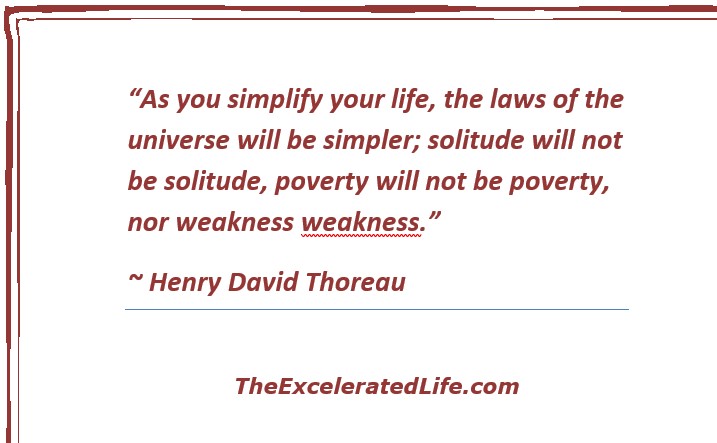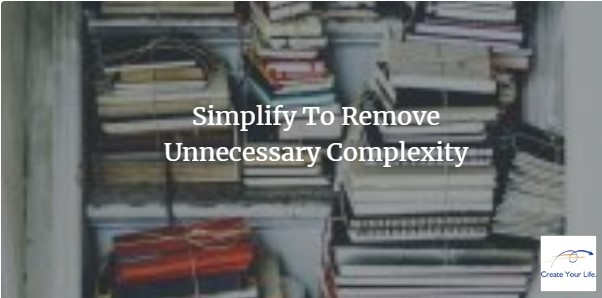The aim of Excelerated Simplicity™ is to free ourselves from unnecessary complexity. The desired end result is a simpler, not simplistic, life. Not all complexity can be done away with, nor is that desirable. But unnecessary complexity can be simplified and our lives made simpler by having fewer trivial details to deal with.
TheExceleratedLife.com

A Rube Goldberg Contraption
In case you’ve ever wanted a self-operating napkin, here is a design for one you can use while eating soup. [“Rube Goldberg”]
- When you raise the soup spoon to your mouth, it pulls an attached string.
- The string jerks a ladle to which it is attached.
- The swinging ladle tosses a cracker past a toucan, sitting on a balanced perch.
- When the toucan jumps after the cracker, the perch tilts, spilling seeds into a tiny pail.
- The added weight in the pail causes it to pull a cord which is attached to a lighter.
- The pull on the cord opens and ignites the lighter.
- The burning lighter sets off a skyrocket.
- The skyrocket flies off, pulling an attached sickle.
- The sickle cuts a string holding the pendulum of a clock.
- The freed pendulum, with a napkin attached, swings back and forth, causing the napkin to wipe your chin.
And oh, by the way, you’re wearing this contraption on your head as this picture illustrates.
Unnecessary Complexity
Rube Goldberg was an American cartoonist famous for drawing complicated devices that performed a simple task in convoluted ways. [“Rube Goldberg”] In this way, Goldberg shone a humorous light on our tendency to over-complicate things.
Unnecessary complexity in real life is not always so humorous. Complexity costs money and valuable time, tries our patience, and undermines trust. Unnecessary complexity can be avoided or corrected, however.
Keys to simplifying complexities include focusing on the practical and efficient, being willing to collaborate and share your ideas, and communicating: being open to feedback and asking for help when you need it. [“Unnecessary Complexity”]
Complicated Vs. Complex
Before we look at ways to simplify unnecessary complexities, let’s draw a contrast between complex and complicated.
Think about assembling a computer, or a car, or the motherboard of a smartphone. These are complicated items with hundreds, even thousands, of parts, requiring the work of many different people. But when these and other complicated products are assembled in a specific order, not deviating from established routines, the end result is predictable. [Ashkenas]
In complex matters, there can be lots of inputs, but they vary and there are no routines, or the routines are not always followed. Results, in this case, are unpredictable.
So, to contrast the two, complicated = lots of parts but a predictable result, while complex = no prescribed routine and unpredictable results. Computers are complicated. Human beings are complex.
As you consider areas in your life that you may want to simplify, remember this. A routine may be complicated, but if it has no more steps than necessary, and always yields the same result, it is probably not overly complex. Look for areas that are not consistent in the results they provide. These are likely candidates for simplification.
Key Factors Fueling Complexity
In Simple: Conquering The Crisis Of Complexity, Alan Siegel and Irene Etzkorn identify a number of factors that contribute to complexity. They are writing primarily for the corporate world, but much of what they say is relevant to unnecessary complexity in our personal lives as well.
o Learned helplessness. [Siegel] First identified by Dr. Martin Seligman, learned helplessness refers to the tendency to quit trying when we think our efforts will have no bearing on the situation. “When someone has several experiences of being confused,” write Siegel and Etzkorn, “that person starts assuming they’ll never be able to understand any legal document, so why bother trying?” [Siegel] We think if it’s hard to understand, it must have been done by someone smarter than we are. Not true.
o Complexity is used as a shield. [Siegel] In the corporate world, this shows up as long, wordy documents that attempt to “address every possibility, no matter how remote.” [Siegel] From a personal standpoint, if you and I think we have to have plans for every possible contingency, for example before we begin a project, we are adding unnecessary complexity.
o Complexity gets worse over time. [Siegel] Complexity builds upon itself, adding layer upon layer.
o People mistakenly believe that more information equals greater clarity. [Siegel] Actually, the opposite is generally true.
Aspects Of Simplicity
As you take steps to simplify and reduce unnecessary complexity in your life, reflect on these aspects of simplicity as identified by Siegel and Etzkorn. [Siegel]
- Transparency – “laying bare the underlying truth whatever it reveals”
- Clarity – having a “clear intent that quickly conveys its purpose or use”
- Essence – “cutting to what matters”
- Usability – “making something fit for its purpose”
These are useful tools as you look for ways to simplify.
Simplicity ≠ Simplistic
As you take steps to cut out unnecessary complexity in your goals, plans, routines, and actions, don’t confuse simplicity with simplistic, which is treating things as simpler than they really are.
Simplicity’s goal is to find the simplest way to accomplish something. Its aim is to strip away all that isn’t essential and express what’s left in the clearest possible way. [Few] Simplicity is “the happy medium between too much and too little.” [Few]
As Albert Einstein supposedly said: “Things should be made as simple as possible, but not simpler.” We humans are complex — and complicated — creatures. It is good to simplify areas that are unnecessarily complex, but let’s avoid being simplistic and risking overlooking things that must be done.
Tools For Simplifying
Here are some tools you can use when looking to simplify areas of unnecessary complexity in your life. [Ashkenas] As you examine your roles, goals, plans, routines, work, chores, any area that you want to simplify, consider how you can put these tools to use.
Prioritize. You must identify and focus on the things that are truly important for accomplishing your desired result. “Things which matter most,” said Johann Wolfgang von Goethe, “must never be at the mercy of things which matter least.”
Say ‘no’. Once you have your priorities identified, learn to say “no” to anything else, no matter how entertaining or easy or quick it may appear. “And the way you do that,” Stephen Covey tells us, “is by having a bigger ‘yes’ burning inside.”
Be willing to iterate. Act. Get feedback. Learn. Modify and improve. Or, as Brian Johnson says: Start. Finish. Ship. Repeat.
Identify the essence. Cut to the chase and do what is important, nothing more.
“Simplify, simplify!”
Look at your routines, your household chores, your work, your lifestyle. Is there any unnecessary complexity? Where can you simplify? Examine one specific candidate. Identify what is important. Prioritize the steps. Identify other things you may need to drop, to say “no” to. Iterate: Act, get feedback, learn. Modify and improve. Repeat.
“Our life is frittered away by detail. Simplify, simplify, simplify!” ~ Henry David Thoreau
The aim of Excelerated Simplicity™ is to free ourselves from unnecessary complexity. The desired end result is a simpler, not simplistic, life. Not all complexity can be done away with, nor is that desirable. But unnecessary complexity can be simplified and our lives made simpler by having fewer trivial details to deal with. The end result is less stress, more time for the important things, less wasted effort, more peace of mind. That is embracing the Excelerated Life™!
Excelerated Simplicity™ — freeing yourself from unnecessary complexity — is one step in creating your Excelerated Life™, a life of flourishing and well-being, and a life of meaning, purpose, and service.
Read more about the Excelerated Life™.
Resources:
Ashkenas, Ron. “For Stronger Leadership, Cut Through Complexity.” Duke Corporate Education. Duke Corporate Education, September 2013. Web. November 28, 2020.
https://www.dukece.com/insights/for-stronger-leadership-cut-through-complexity/
Few, Stephen. “The Scourge of Unnecessary Complexity.” Visual Business Intelligence. Perceptual Edge, December 16th, 2013. Web. November 28, 2020.
https://www.perceptualedge.com/blog/?p=1817
“Rube Goldberg Machine.” en.wikipedia.org. Wikimedia Foundation, Inc., December 6, 2020. Web. December 9, 2020.
https://en.wikipedia.org/wiki/Rube_Goldberg_machine
Siegel, Alan and Irene Etzkorn. Simple: Conquering The Crisis Of Complexity. New York: Hatchette Book Group, Inc, 2013.
“Unnecessary Complexity: The Rube Goldbergs of the Personality Types.” 16 Personalities. NERIS Analytics Limited,. Web. November 28, 2020.
https://www.16personalities.com/articles/unnecessary-complexity-the-rube-goldbergs-of-the-personality-types


